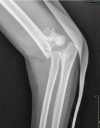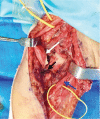Median Nerve Entrapment after Supracondylar Humeral Fracture in a Young Child
- PMID: 31781449
- PMCID: PMC6875267
- DOI: 10.1155/2019/1543126
Median Nerve Entrapment after Supracondylar Humeral Fracture in a Young Child
Abstract
Median nerve entrapment after supracondylar humeral fracture in children is rare. We report a case of Gartland type III supracondylar humeral fracture complicated by an entrapment of the median nerve following closed reduction and percutaneous pinning in a 5-year-old child. The diagnosis of entrapment was made 14 months post injury following progressive motor and sensory palsy. Resection and end-to-end suture were performed, leading to complete sensory and motor recovery eight months later. This nerve complication is often unnoticed and should be suspected systematically before and after reduction of all displaced supracondylar humeral fracture in children. The indication of resection-suture or nerve graft depends on the entrapment and the delay of the palsy.
Copyright © 2019 C. Granier et al.
Conflict of interest statement
The authors declare no conflict of interests.
Figures








Similar articles
-
Pulseless Supracondylar Humerus Fracture With Anterior Interosseous Nerve or Median Nerve Injury-An Absolute Indication for Open Reduction?J Pediatr Orthop. 2019 Jan;39(1):e1-e7. doi: 10.1097/BPO.0000000000001238. J Pediatr Orthop. 2019. PMID: 30080770
-
Ipsilateral supracondylar fracture and forearm bone injury in children: a retrospective review of thirty one cases.Kathmandu Univ Med J (KUMJ). 2011 Apr-Jun;9(34):11-6. doi: 10.3126/kumj.v9i2.6280. Kathmandu Univ Med J (KUMJ). 2011. PMID: 22610861
-
The posterior intrafocal pin improves sagittal alignment in Gartland type III paediatric supracondylar humeral fractures.Injury. 2016 Apr;47(4):842-7. doi: 10.1016/j.injury.2015.12.031. Epub 2015 Dec 31. Injury. 2016. PMID: 26777466
-
Advantages and disadvantages of the prone position in the surgical treatment of supracondylar humerus fractures in children. A literature review.Injury. 2018 Nov;49 Suppl 3:S37-S42. doi: 10.1016/j.injury.2018.09.046. Epub 2018 Sep 27. Injury. 2018. PMID: 30286976 Review.
-
Low incidence of ulnar nerve injury with crossed pin placement for pediatric supracondylar humerus fractures using a mini-open technique.J Orthop Trauma. 2005 Mar;19(3):158-63. doi: 10.1097/00005131-200503000-00002. J Orthop Trauma. 2005. PMID: 15758668 Review.
References
Publication types
LinkOut - more resources
Full Text Sources

